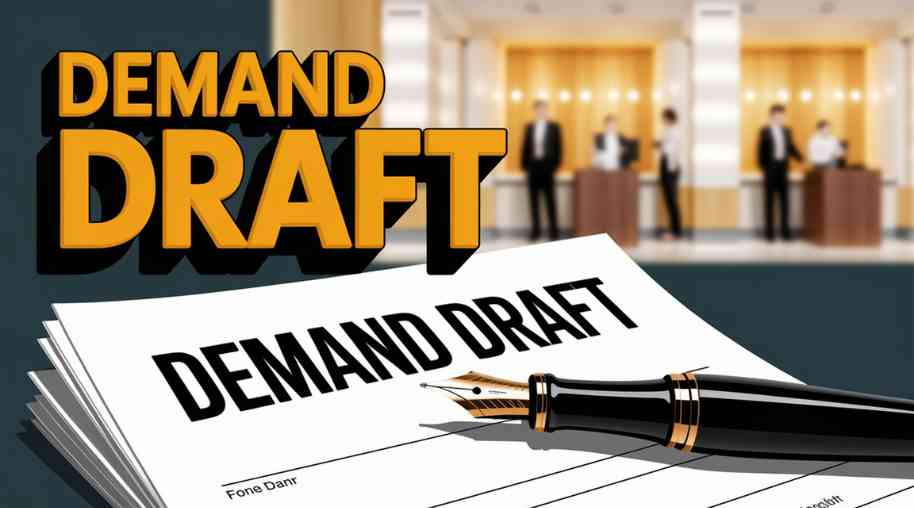DD Full Form - Demand Draft
by Shashi Gaherwar
0 1051
Demand Draft: Meaning, Process, Advantages, and Comparison
Introduction
A Demand Draft (DD) is a financial instrument issued by a bank that guarantees payment to the recipient. Unlike cheques, which may bounce due to insufficient funds, a demand draft is prepaid, ensuring security and reliability in financial transactions. It is commonly used in transactions requiring a high degree of trust, such as university fees, government payments, and business transactions.

This article explores the meaning, process, advantages, limitations, and comparison of demand drafts with other payment methods.
What is a Demand Draft?
A Demand Draft (DD) is a negotiable instrument issued by a bank on behalf of a customer, instructing another bank or branch to pay a specified amount to the beneficiary. The payer deposits the money with the bank, which then guarantees payment to the recipient. Since the amount is prepaid, there is no risk of insufficient funds, making DDs a secure mode of transaction.
How Demand Draft Works
Applying for a Demand Draft
A person or entity approaches a bank and fills out a Demand Draft Application Form. The form includes details such as the amount, beneficiary name, and issuing branch. The applicant pays the amount along with applicable bank charges.
Issuance of the Demand Draft
The bank processes the request and issues a DD with a unique serial number. The draft is crossed, meaning it can only be deposited into the payee’s bank account and not encashed directly.
Delivery to the Beneficiary
The applicant sends the DD to the beneficiary, who deposits it into their bank account.
Clearing and Settlement
The payee’s bank processes the demand draft and credits the amount into the account. Since the DD is backed by the issuing bank, there is no risk of payment failure.
Advantages of Demand Draft
Security and Reliability
Since the payment is prepaid, the recipient does not face the risk of a bounced cheque.
Universally Accepted
DDs are widely used for transactions such as government fees, university admissions, and vendor payments.
No Need for a Bank Account
Unlike cheques, which require both parties to have a bank account, a demand draft can be obtained using cash.
Protection Against Fraud
Demand drafts are more secure than cash transactions and can be traced easily.
Facilitates Large Transactions
DDs are commonly used for making high-value payments that require guaranteed funds.
Disadvantages of Demand Draft
Processing Fees
Banks charge a fee for issuing a DD, making it more expensive than cheques or online transfers.
Not Instantaneous
Unlike digital transactions, a DD requires physical handling and may take a few days for processing.
Loss or Damage Risk
If a DD is lost, it takes time to cancel and reissue a new one, requiring additional paperwork.
Limited Flexibility
A demand draft is non-negotiable, meaning it can only be deposited in the named beneficiary’s account.
Demand Draft vs. Cheque vs. Bank Transfer
A demand draft is prepaid, ensuring guaranteed payment, whereas a cheque may bounce due to insufficient funds. A bank transfer, such as NEFT or RTGS, is also secure and usually processed instantly. Unlike cheques, which require both parties to have a bank account, a demand draft can be issued using cash. While demand drafts involve bank charges, cheques usually do not have fees, and bank transfer charges vary depending on the bank and transaction type.
How to Cancel a Demand Draft
Visit the Issuing Bank
The person who requested the DD must visit the bank with valid ID proof.
Submit a Cancellation Request
A written request, along with the original DD, must be provided.
Bank Processing
The bank will verify the details and refund the amount after deducting cancellation charges.
Refund Process
The amount is usually refunded to the original mode of payment.
Common Uses of Demand Draft
Demand drafts are commonly used in university and college fee payments, government transactions and tenders, business payments to vendors, real estate and property transactions, and international trade and business deals.
How to Track a Demand Draft
A demand draft can be tracked using the unique DD serial number provided by the bank. The issuing bank can also be contacted for status updates, and some banks offer online tracking services through their portals.
Future of Demand Drafts
With the rise of digital payments and online banking, the use of demand drafts has declined. However, they remain a preferred method for transactions requiring security and verification. As banking evolves, electronic alternatives like NEFT, RTGS, and UPI are replacing traditional instruments like DDs.
A Demand Draft (DD) remains a reliable and secure mode of payment for transactions requiring guaranteed funds. It is widely used in educational, government, and business transactions where payment security is essential. Despite the increasing use of digital banking, demand drafts continue to play a crucial role in the financial system.
Understanding how to obtain, use, and cancel a demand draft helps individuals and businesses leverage this payment instrument effectively. With ongoing advancements in banking, electronic alternatives may eventually replace demand drafts, but they will continue to serve as a valuable financial tool in certain transactions.

Share:








Comments
Waiting for your comments